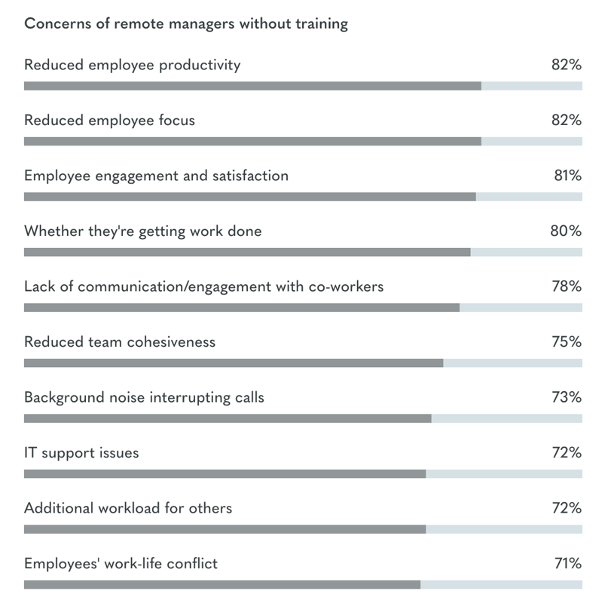Creative agencies have been quick to adapt to the coronavirus pandemic by transitioning employees to remote work. However, due to the collaborative and deadline-driven environment of most agencies, working remotely comes with its own challenges.
According to a 2019 OWL Labs survey, the top concerns of managers of remote employees include reduced employee productivity and focus, lack of communication, and reduced team cohesiveness.
In this unprecedented time, designers, copywriters, consultants, and managers must transition the way they collaborate and communicate to ensure client work stays on track. While remote work will take some getting used to, here are 6 steps to help creative agencies ease into remote work and collaborate effectively with coworkers.

Source: OWL Labs,
https://www.owllabs.com/state-of-remote-work/2019
Step 1: Clarify and Prioritize Goals
Creative agencies set goals and priorities to best suit their client needs and ensure they are providing value. Remote work can make it harder to act on these goals since employees have to make a greater effort to share their ideas.
Goals should always have a priority assigned to them. Prioritization allows team members to pivot where necessary and take on projects that are most pressing. Some team goals may have more of an internal purpose, focusing on maintaining current workloads or growing the account further. Client-centered goals may focus on metrics like sales conversions, foot traffic, and exposure to the target customer. The team can foster communication and trust with the client by insisting on measurability and providing metrics on the implementation and success of each goal.
If client work is slow, employees can still establish value to their clients by doing additional research on potential client needs. This could include researching industry trends, conducting in-depth interviews, or doing field surveys. The insights gained from these research methods can expand the client’s scope and potentially lead to more work in the future.
Step 2: Identify Necessary Tools
There are a variety of web-based tools to help any team and any project. There are four main categories of tools your team should familiarize yourself with: communication tools, project management tools, cloud storage tools, and productivity tools.
Communication tools include video conferencing and messaging applications to facilitate communication between teammates. Some prominent video conferencing tools are Zoom, GoToMeeting and Skype, and popular messaging applications include Slack, GroupMe and Whatsapp. Project management tools including ProofHub, Basecamp, and Scoro are web-based applications to keep your projects organized and on schedule. Cloud storage tools like Dropbox and Google drive allow for a communal place for your team to save files, assets, and updates. Lastly, productivity tools including Trello and Evernote help teams manage their time and stay on track with to-do lists and note-taking.
With remote work it’s important to make sure everyone on the team has access to the tools and knows know to use them properly. Establish consensus with your team to select the appropriate tools and schedule an initial check-in to make sure everyone is understanding and using the tools correctly.
For in-depth lists of tools, check out these articles from ProofHub and Scoro:
https://www.proofhub.com/articles/remote-work-tools-for-team
https://www.scoro.com/blog/remote-employee-management-tools/
Step 3: Establish Abundant Communication
Communication is the bedrock of any successful team, but especially for creative agencies. Projects will often need to be passed multiple times between managers, copywriters, consultants, and designers. Constant communication fosters accountability between employees and keeps deadlines on track.
One way to establish communication is with daily status updates. Have each team member write a list of goals for the day and share them with the team. At the end of each day have team members reflect on what was completed versus what is still in progress. Another way to establish communication is through manager and coworker check-ins. In an office setting, employees can regularly pop into their manager’s or coworker’s office and ask for feedback or help. While working remotely, managers and coworkers should occasionally check in with their employees to ensure there are no issues or hang-ups. A third way to increase communication is through weekly reporting. Utilizing metrics, have team members quantify and report back trends for the week. This could include the amount of collateral pieces worked on and completed, the analytics of social media and web traffic, or the efficiency of existing processes. By evaluating data week by week, you can establish trends as well as goals for improvement.
Step 4: Encourage Cross-Collaboration
Most creative agencies have multiple projects and multiple teams operating simultaneously. While working from home, employees in creative agencies may feel that they are in an information “silo,” and unaware of the other projects going on. Team leads can break down these silos by encouraging cross-collaboration. This could include group brainstorming and concepting, or mock client meetings where team members can critically evaluate their coworkers’ work. Cross-collaboration opens the door to new ideas and allows team members to take a step back from their own work to critically evaluate its effectiveness.
Step 5: Maintain Workplace Culture
Team culture does not have to suffer due to remote work. While deadlines and client work are the priority, it is also important to establish social activities to keep everyone on the team engaged.
One idea is to host a virtual happy hour by starting a group video call and encouraging employees to enjoy their own food and beverages. Make sure to have a set of non-work-related conversation topics. Another activity is “Show and Tell” where each person on the team presents an item, photo, or personal project they are proud of. This allows you to learn about each other’s hobbies and interests and collect a few conversation starters for later. A third activity would be a “Bring Your Family to Work Day” where you encourage employees to allow their kids, partners, and pets to sit in on and participate on video calls with the team. Lastly, there is a wide variety of virtual games you can play with your team including Pictionary, Trivia, Bingo, and Charades. For a more comprehensive list, check out: https://www.twoscotsabroad.com/zoom-video-conference-call-games/
Step 6: Develop a System for Feedback
Teams tend to deprioritize feedback when working remotely because individuals are focused on their own work. However, feedback is incredibly important because it allows employees to be aware of what is expected of them as well as what is expected of the team. In this final step, the goals set in step one must be evaluated on an individual level.
One way to overcome the feedback obstacle is to set regularly occurring one-on-one video calls. These calls should not just focus on task completion but should be an evaluation of quality of work as well. Quickly, managers will be able to understand the level of self-motivation of their employees and what challenges their employees are facing. From there, managers can tailor their feedback to improve productivity, boost metrics, or expand concept generation.
Most importantly, feedback gives employees the opportunity to know that their work matters. By acknowledging accomplishments of employees and sharing that with the team, employees have a model for what good work looks like. From there, employees will adjust their mindsets and remote work mentality to align.
The transition to remote work comes with its own challenges and difficulties, but with these 6 steps, collaboration and communication will flourish at your creative agency while everyone on your team works from home.
About Weber Associates
Weber Associates is a Columbus, OH-based consulting firm. Since 1985, we have blended the creativity of a marketing agency with the analytical rigor of a consultancy to help our clients solve real sales and marketing challenges so they can significantly grow revenues and customer loyalty.


